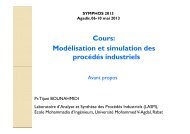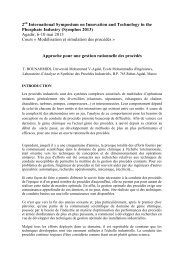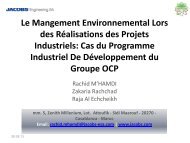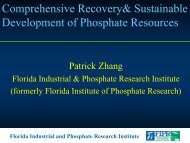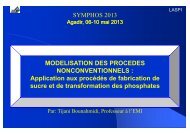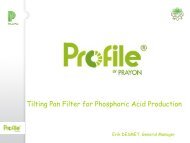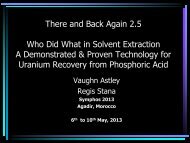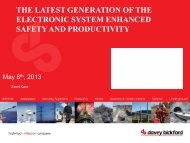Abstract SYMPHOS 2011
Abstract SYMPHOS 2011
Abstract SYMPHOS 2011
You also want an ePaper? Increase the reach of your titles
YUMPU automatically turns print PDFs into web optimized ePapers that Google loves.
RECENT IMPROVEMENT OF THE GRANULATOR PIPE REACTOR FOR THE<br />
PRODUCTION OF GRANULAR AMMONIUM PHOSPHATES<br />
Donal S. Tunks<br />
Jacobs Engineering S.A., Casablanca, MOROCCO<br />
PH-O-14<br />
A Granulator Pipe Reactor can be used in the production of MAP/DAP to increase the production capacity while<br />
substantially reducing the overall fuel consumption. This is accomplished through the mixing of ammonia and<br />
phosphoric acid within the Granulator Pipe Reactor. From the high heat of reaction of this mixing, water is<br />
evaporated prior to the drying step and this causes the significant drop in fuel consumption.<br />
A recent development by Jacobs Engineering involves an elaborate continuous control scheme that maintains the<br />
desired product quality while minimizing fuel consumption by utilizing on-line and at-line measurements.<br />
Adding a Granulator Pipe Reactor to an existing facility is a relatively simple modification which and can pay itself<br />
off in as little as 4 months.<br />
fertilizers.<br />
HOW TO INCREASE THE OVERALL OUTPUT OF PHOSPHORIC ACID<br />
EVAPORATION LOOPS WHILE REDUCING THEIR TOTAL COSOWNERSHIP<br />
Loic BERNARD<br />
SGL Group Saint Martin d’Hères/FRANCE<br />
PH-O-15<br />
The phosphoric acid commercial concentration has been set at 54%. The different wet phosphoric acid processes<br />
used around the world produce green acids with concentrations between 28 and 44% P2O5.thus meaning that<br />
depending on the production process, the acid coming out from the reactor tanks must be concentrated in 1 to 3<br />
evaporation stages. Each evaporation stage consists in an axial pump, a heat exchanger, a flash tank, a scrubber,<br />
and condenser and a vacuum pump. Since industrial green phosphoric acid is extremely corrosive, rubber lined flash<br />
tank and piping, a graphite heat exchanger and an axial pump in nickel-alloy are usually used.<br />
In order to sustain a high productivity of the evaporation loop, the appropriateness between the axial pump<br />
characteristics (curve) and the heat exchanger characteristics (tube diameter, length, cross section) is one of the<br />
key to success. A high velocity in the heat exchanger means a better overall heat transfer coefficient and therefore<br />
a larger output. It might also result in a lower fouling and therefore longer evaporation cycles between cleaning<br />
cycles. However, throughout the complete evaporation cycle, the progressive fouling of the heat exchanger will<br />
result in lower performances, higher pressure drops and therefore lower velocities thus leading to the further<br />
reduction of the performances. The proper selection, design and sizing of the axial pump (construction design and<br />
materials, characteristic curve) and of the graphite heat exchanger (graphite quality, cross section, tube length,<br />
steam bustle, carbon fiber reinforced tubes, expansion system) associated with smooth operations (especially<br />
during start-ups and shut-downs) guaranty a higher productivity, a better reliability, a longer equipment life time<br />
and therefore overall a much higher output and a lower total cost of ownership.<br />
63






